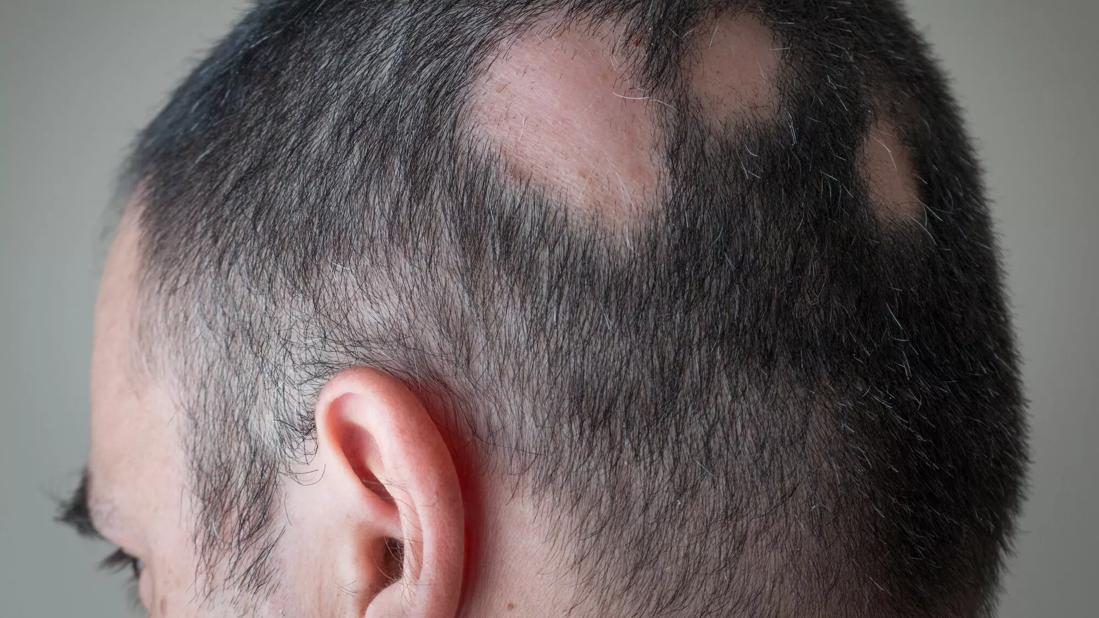A gentle hair care routine, stress reduction and sun protection can help reduce flares and maintain your locks

Alopecia areata isn’t a disease that makes you ill in the traditional sense. Losing patches of hair won’t shorten your life or make it difficult to walk or talk. The condition doesn’t cause physical pain.
Advertisement
Cleveland Clinic is a non-profit academic medical center. Advertising on our site helps support our mission. We do not endorse non-Cleveland Clinic products or services. Policy
But the autoimmune disorder can be devastating and even debilitating in its own way. It can fuel depression and anxiety and lead to social isolation and absences from work or school.
That’s why managing your alopecia areata and practicing self-care is so important. Seemingly minor things that you do day after day — like how you brush your hair — can make a major difference.
We asked dermatologist Melissa Piliang, MD, for some advice to make living with alopecia areata a little easier.
Alopecia areata doesn’t just go away and there isn’t a known cure for the disease. Approved treatments for the condition may help you minimize symptoms, but they’re not a permanent solution.
So, what can you do? Well, there are steps you can take to maybe reduce alopecia areata flare-ups and lessen their effects. Here are a few areas where you can make a difference.
Your hair care routine can make a difference when it comes to the extent of hair loss from alopecia areata. Dr. Piliang offers these suggestions.
Advertisement
That mop of hair atop your head exists for more than just stylistic purposes. Put those hair strands together and they form a protective layer that shields your scalp from the sun’s harmful ultraviolet (UV) rays.
Bald patches left by an alopecia areata flare-up expose your skin to those damaging rays, a top cause of skin cancer. The direct angle at which sunlight hits your head only increases the risk.
“It’s really important to be careful in the sun if you have any hair loss,” says Dr. Piliang.
You can protect yourself by:
Hair provides warmth and insulation for your noggin. If alopecia areata leaves a few bare patches on your head … well, you’re going to lose a bit of heat from those spots.
“When the temperature starts to drop, you’re going to feel colder sooner,” shares Dr. Piliang. “You may find that you need to wear a hat in the fall as opposed to waiting until the winter months.”
Sleeping caps may also come in handy when you go to bed given cooler temperatures at night.
Alopecia areata can affect more than the tresses on your head. It can also target hair anywhere on your body, leading to the loss of eyebrows, eyelashes and nose hair, with a whole different set of complications.
Here are a few ways to handle hair loss in areas other than the top of your head:
Eyebrows aren’t just a decorative touch above your peepers. Those expressive swooshes of hair help keep sweat, water or random gunk from trickling down your forehead and into your eyes.
If you lose your eyebrows, Dr. Piliang suggests wearing a hat, headband or bandana to absorb sweat and water.
Although eyelashes are among the shortest hairs on your body, they hold an important job. Those tiny hairs guard your eyes by blocking dirt, grit and dusty debris floating around your environment.
Wearing glasses or sunglasses can help fill the void if you lose your eyelashes, says Dr. Piliang.
If your eyes do get irritated, make sure to have eye drops (such as artificial tears) available to soothe any discomfort and reduce redness.
Nose hairs may not be pretty, but that’s because they do some seriously dirty work filtering the air you breathe in through your nostrils. It’s like having your own personal air purification system.
Advertisement
Losing nose hair can lead to increased allergy symptoms, infections and dryness that causes a bloody nose.
Covering your nose (such as by wearing a mask) can reduce debris floating into your nostrils. To combat the dryness, running a humidifier at night while you sleep can help increase moisture.
Sudden hair loss from alopecia areata can be very stressful — and stress is not a friend to your immune system, says Dr. Piliang. The impact it has on your body can make it more difficult to rebound from a flare-up.
“Managing stress and the stress caused by alopecia areata is very important, both for your quality of life and working through the disease,” she continues.
Find something to help you destress, whether it’s through:
Seasonal allergies like hay fever can trigger alopecia areata. “Managing your allergies and taking antihistamines is very important,” says Dr. Piliang.
Up until June 2022, there was no approved treatment for alopecia areata. Now, there are several medications and treatment options that have been OK’d for use by the U.S. Food and Drug Administration (FDA).
Advertisement
“There are options now that weren’t available before,” notes Dr. Piliang. “Talk to your healthcare provider about what might be available.”
Alopecia areata also is associated with other autoimmune diseases, including thyroid disease. Regularly seeing your healthcare provider offers an opportunity to detect and start treatment for any other issues.
Alopecia areata is an unpredictable disease. One day you may have a full head of hair, the next you may have a coin-sized bald patch or patches. There’s often no rhyme or reason for why it strikes.
But adding a few self-care techniques to your routine might reduce how often you have flare-ups and their intensity. “There are no guarantees,” says Dr. Piliang, “but doing these things may make the situation a little better.
Advertisement
Learn more about our editorial process.
Advertisement

Take steps to reduce stress by practicing meditation, finding time to relax and maintaining a healthy lifestyle

You may see pitting, brittleness or ridges in your fingernails and toenails

Your immune system may attack hair follicles anywhere on your body

It’s normal to lose around 50 to 150 strands per day to routine hair shedding

Studies are mixed, but frequently wearing very tight, warm hats could stress your follicles and lead to hair loss

Things like stress, heated styling and other health conditions may cause you to lose more hair than normal

Creatine does cause some side effects, but hair loss probably isn’t one of them

Home remedies may help your hair, but don’t expect them to cure the autoimmune disease

Babies can get congested easily, but you can calm their cough by keeping them hydrated, using nasal drops and running a humidifier

Weight loss may cause loose, sagging skin and muscle loss to your rear

Several conditions, like vitiligo and fungal infection, can cause a loss of pigmentation, leading to white spots or patches on your skin